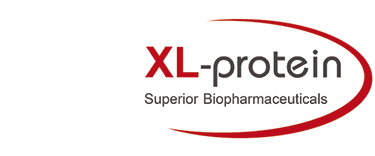In the past years, drug delivery of small molecules as well as macromolecular therapeutics via nanoparticles has gained significant attention in the pharma/biotech industry. Nevertheless, their clinical translation is still facing challenges, like toxicitiy, unfavorable pharmacokinetics, poor tumor targeting as well as difficult manufacturing. XL-protein’s PASylation technology solves these issues, as demonstrated by multiple publications. The non-toxic, fully biodegradable PAS-polymer is an attractive tool to improve the efficiency of drug and gene delivery systems and to create next generation nanomedicines.
Expanded hydrodynamic volume
- extended circulation time
- reduced injection frequencies
- tumor enrichment via the EPR effect
Inert and highly hydrophilic
- Hydrophilic surface shielding
- Reduced macrophage uptake
- No unspecific nanoparticle binding
PAS polypeptides:
- Improve the stability of nanoparticles
- Reduce drug leakage
- Facilitate drug encapsulation
Genetically encoded PAS enables incorporation of:
- Tumor targeting domains
- Tumor protease cleavage sites
Related publications
Tesarova B., Dostalova S., Smidova V., Goliasova Z., Skubalova Z., Michalkova H., Hynek D., Michalek P., Polanska H., Vaculovicova M., Hacek J., Eckschlager T., Stiborova M., Pires .S., Neves A.R.M., Abrantes A.M., Rodrigues T., Matafomei P., Botelhog M.F., Teixeira P., Mendes F., Heger Z. (2020) Surface-PASylation of ferritin to form stealth nanovehicles enhances in vivo therapeutic performance of encapsulated ellipticine. Applied Materials Today 18, 100501.
Krishnamurthy S., Muthukumaran P., Jayakumar M.K.G., Lisse D., Masurkar N.D., Xu C., Chan J.M., Drum C.L. (2019) Surface protein engineering increases the circulation time of a cell membrane-based nanotherapeutic. Nanomedicine, 18, 169-178.
Damiani V., Falvo E., Fracasso G., Federici L., Pitea M., De Laurenzi V., Sala G. and Ceci P. (2017) Therapeutic Efficacy of the Novel Stimuli-Sensitive Nano-Ferritins Containing Doxorubicin in a Head and Neck Cancer Model Int. J. Mol. Sci. 18:1555.
Fracasso G., Falvo E., Colotti G., Fazi F., Ingegnere T., Amalfitano A., Doglietto G.B., Alfieri S., Boffi A., Morea V., Conti G., Tremante E., Giacomini P., Arcovito A., Ceci P. (2016) Selective delivery of doxorubicin by novel stimuli-sensitive nano-ferritins overcomes tumor refractoriness. J. Control. Release
239, 10-18.Falvo E., Tremante E., Arcovito A., Papi M., Elad N., Boffi A., Morea V., Conti G., Toffoli G., Fracasso G., Giacomini P., Ceci P. (2016) Improved doxorubicin encapsulation and pharmacokinetics of ferritin-fusion protein nanocarriers bearing proline, serine, and alanine elements. Biomacromolecules 17, 514-522.

